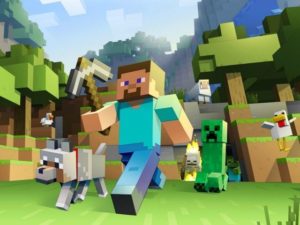More ‘Child’s Pay…’
 Minecraft: Education Edition has officially released a 1.0 edition. It introduces valuable tools for students and educators alike — both in and out of the game.
Minecraft: Education Edition has officially released a 1.0 edition. It introduces valuable tools for students and educators alike — both in and out of the game.
With more than 25 million sales on the PC/Mac platform alone, and over 100 million total copies sold as of June 2016, the blocky virtual world is more populated than most countries on Earth. It’s moved beyond “popular game” and into “major cultural influencer” (???) for the next generation of creative young minds.
In the recent past, Minecraft: Education Edition added thousands more users, giving teachers the chance to tap into its boundless potential for engaging students in the classroom. With 1.0, the toolset is now feature complete and ready to move into even more schools.
Teachers can use pre-made Minecraft worlds for everything from learning about windmills or ecology, to the function of the human eye. If they’re uncertain how to begin, Microsoft and developer Mojang have them covered. 60 educators from 19 countries have been recruited for regular blog posts, lesson plans, and other supplemental help for those looking to implement Minecraft into their teaching strategy.
The 1.0 version also brings some mechanical and quality of life features. The game world can be built twice as high to accommodate complex projects, teachers can pause the game across their whole classroom, and the worlds in which the children work can be much more easily uploaded and shared.
Minecraft has a great track record as an educational asset, and it’s only getting better. In addition to the robust feature set already implemented, Minecraft is positioned to be a truly valuable tool in the hands of teachers looking to engage the most connected generation in history.
Written by Nate Church and published on Breitbart ~ January 25, 2017.
Bring back Dick and Jane…
 FAIR USE NOTICE: This site contains copyrighted material the use of which has not always been specifically authorized by the copyright owner. We are making such material available in our efforts to advance understanding of environmental, political, human rights, economic, democracy, scientific, and social justice issues, etc. We believe this constitutes a ‘fair use’ of any such copyrighted material as provided for in section 107 of the US Copyright Law. In accordance with Title 17 U. S. C. Section 107, the material on this site is distributed without profit to those who have expressed a prior interest in receiving the included information for research and educational purposes. For more information go to: http://www.law.cornell.edu/uscode/17/107.shtml
FAIR USE NOTICE: This site contains copyrighted material the use of which has not always been specifically authorized by the copyright owner. We are making such material available in our efforts to advance understanding of environmental, political, human rights, economic, democracy, scientific, and social justice issues, etc. We believe this constitutes a ‘fair use’ of any such copyrighted material as provided for in section 107 of the US Copyright Law. In accordance with Title 17 U. S. C. Section 107, the material on this site is distributed without profit to those who have expressed a prior interest in receiving the included information for research and educational purposes. For more information go to: http://www.law.cornell.edu/uscode/17/107.shtml
